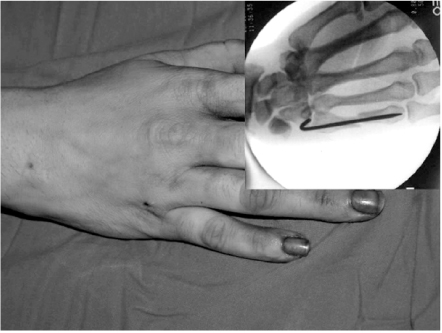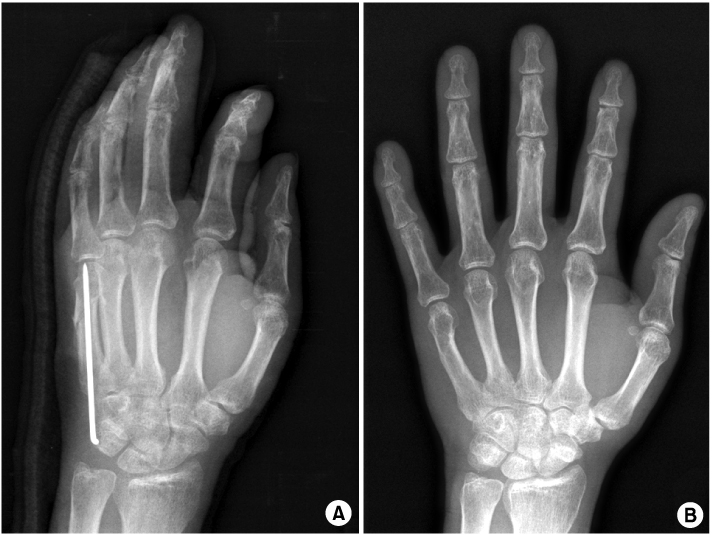J Korean Fract Soc.
2010 Oct;23(4):367-372. 10.12671/jkfs.2010.23.4.367.
Percutaneous Retrograde Intramedullary Pin Fixation for Isolated Metacarpal Shaft Fracture of the Little Finger
- Affiliations
-
- 1Department of Orthopaedic Surgery, CHA Bundang Medical Center, CHA University, Seongnam, Korea. hsoohong@hanmail.net
- KMID: 1461493
- DOI: http://doi.org/10.12671/jkfs.2010.23.4.367
Abstract
- PURPOSE
To evaluate the anatomic and functional outcome of retrograde intramedullary single wire fixation for metacarpal shaft fractures of the little finger.
MATERIALS AND METHODS
hirty one consecutive patients with closed metacarpal shaft fractures of the little finger who have been treated with retrograde intramedullary single wire fixation were evaluated. Fracture union and angulation were analyzed radiologically, and clinical evaluations were performed including range of motion, DASH score and complications.
RESULTS
Fracture union was achieved in all cases and callus formation was obvious at postoperative 41 days. Average angulation of fracture site was 3degrees in the coronal plane and 1.2degrees in the sagittal plane at the last follow up and no measurable metacarpal shortening was observed. Mean TAM was 253degrees and DASH score was 2.6. There were two cases of pin migration as intermediate complications.
CONCLUSION
Closed reduction with subsequent percutaneous retrograde K-wire fixation produced good radiological and functional results. We recommend this minimally invasive technique which provides adequate fixation of displaced little finger metacarpal shaft fractures with good functional results and low morbidity.
Figure
Cited by 1 articles
-
The Treatment Outcomes of the Metacarpal Shaft and Neck Comminuted Fractures Using Modified Percutaneous Retrograde Intramedullary Kirschner Wire Fixation
Seok Woo Hong, Young Ho Lee, Min Bom Kim, Goo Hyun Baek
Arch Hand Microsurg. 2018;23(3):175-183. doi: 10.12790/ahm.2018.23.3.175.
Reference
-
1. Choi JY, Shin HK, Son KM, Ko CS. Operative treatment in fracture-dislocations of carpometacarpal joints. J Korean Fract Soc. 2005. 18:443–451.
Article2. Diao E. Metacarpal fixation. Hand Clin. 1997. 13:557–571.
Article3. Downing ND, Davis TR. Intramedullary fixation of unstable metacarpal fractures. Hand Clin. 2006. 22:269–277.
Article4. Faraj AA, Davis TR. Percutaneous intramedullary fixation of metacarpal shaft fractures. J Hand Surg Br. 1999. 24:76–79.
Article5. Flatt AE. Closed and open fractures of the hand. Fundamentals of management. Postgrad Med. 1966. 39:17–26.6. Foucher G. "Bouquet" osteosynthesis in metacarpal neck fractures: a series of 66 patients. J Hand Surg Am. 1995. 20:S86–S90.
Article7. Galanakis I, Aligizakis A, Katonis P, Papadokostakis G, Stergiopoulos K, Hadjipavlou A. Treatment of closed unstable metacarpal fractures using percutaneous transverse fixation with Kirschner wires. J Trauma. 2003. 55:509–513.
Article8. Gonzalez MH, Igram CM, Hall RF Jr. Flexible intramedullary nailing for metacarpal fractures. J Hand Surg Am. 1995. 20:382–387.
Article9. Hudak PL, Amadio PC, Bombardier C. Development of an upper extremity outcome measure: the DASH (disabilities of the arm, shoulder and hand) [corrected]. The Upper Extremity Collaborative Group (UECG). Am J Ind Med. 1996. 29:602–608.
Article10. Kelsch G, Ulrich C. Intramedullary k-wire fixation of metacarpal fractures. Arch Orthop Trauma Surg. 2004. 124:523–526.
Article11. Kim MH, Yoo MJ, Kim JP, Lee JH, Lee JW. Bouquet pin intramedullary nail technique of the 5th metacarpal neck fractures. J Korean Fract Soc. 2007. 20:64–69.
Article12. Low CK, Wong HC, Low YP, Wong HP. A cadaver study of the effects of dorsal angulation and shortening of the metacarpal shaft on the extension and flexion force ratios of the index and little fingers. J Hand Surg Br. 1995. 20:609–613.
Article13. Mockford BJ, Thompson NS, Nolan PC, Calderwood JW. Antegrade intramedullary fixation of displaced metacarpal fractures: a new technique. Plast Reconstr Surg. 2003. 111:351–354.
Article14. Orbay J. Intramedullary nailing of metacarpal shaft fractures. Tech Hand Up Extrem Surg. 2005. 9:69–73.
Article15. Westbrook AP, Davis TR, Armstrong D, Burke FD. The clinical significance of malunion of fractures of the neck and shaft of the little finger metacarpal. J Hand Surg Eur Vol. 2008. 33:732–739.
Article
- Full Text Links
- Actions
-
Cited
- CITED
-
- Close
- Share
- Similar articles
-
- Metacarpal Shaft Fracture Treated by Closed Reduction and Percutaneous Intramedullary K-wire Fixationv
- Surgical Techniques for Percutaneous Reduction by Towel Clips and Percutaneous Intramedullary Fixation with Steinmann Pins for Clavicle Shaft Fractures
- Treatment of Metacarpal Shaft Fractures with Retrograde Intramedullary Kirschner-Wire Fixation
- The Treatment Outcomes of the Metacarpal Shaft and Neck Comminuted Fractures Using Modified Percutaneous Retrograde Intramedullary Kirschner Wire Fixation
- Intramedullary Nailing with Knowles Pin for the Clavicle Shaft Fracture






